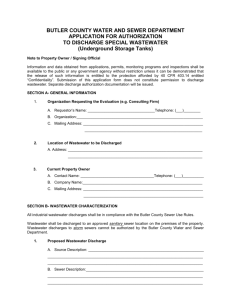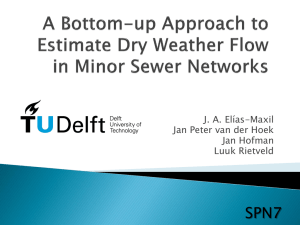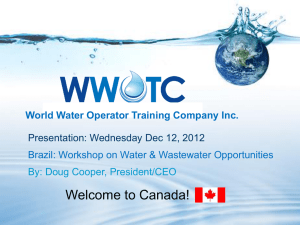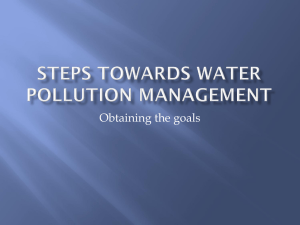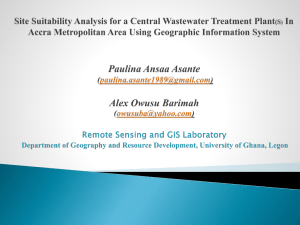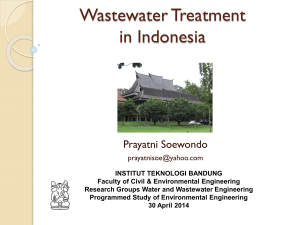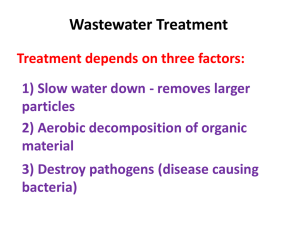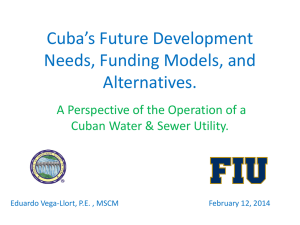Decentralised Wastewater Management
advertisement
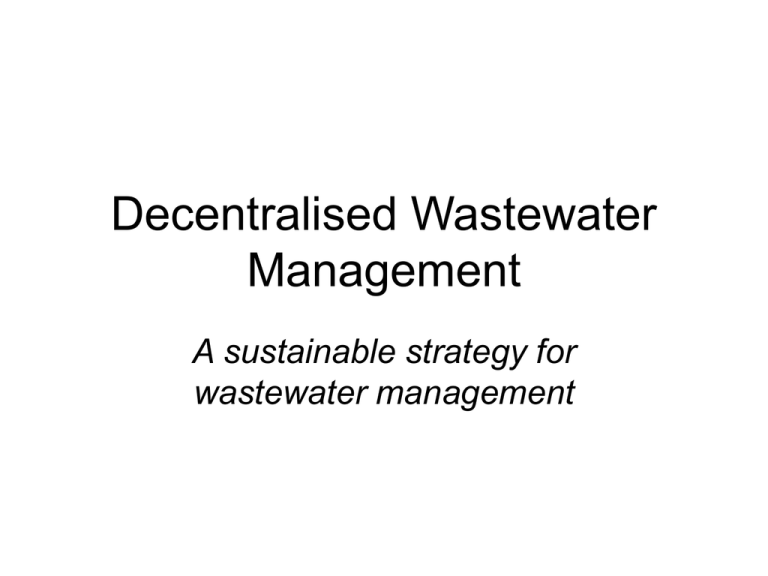
Decentralised Wastewater Management A sustainable strategy for wastewater management Key Message 1. ‘Big Plant’ Not the only Option 2. Consider alternatives to Ocean discharge British Columbia Water and Wastewater Association • Established 1974 • 3,700 Members • Main objective to advance History Wastewater Treatment • Origin of the word ‘Sewer’? • Began as method of improving public health Environmental Concerns led to Construction of WWTP’s What is ‘Decentralised’ Wastewater Management? • Treat locally • Discharge to ground / Re-use water Environmental Benefits – Reduces infiltration and ex-filtration – All sewage captured and treated – Pipes one-sixth the size of conventional pipes because they do not have to accommodate stormwater – No pump stations, no outfalls, no ocean discharge – Water used locally Economic Benefits • Avoid costly piping costs • Sooke LWMP – for new systems • Mobile Alabama : $5,000 / lot Vs $10,00$15,000 for Conventional Sewerage • USEPA Report Figures – decentralised competitive with centralised • Homer Alaska – 10,000 population – 10 / 15 Effluent – Vertreat • Nanoose Bay, Nanaimo – 1,600 population equivalent – Re-use Quality Water – Ecofluid Why a Decentralised Approach? • Economic Drivers – Reduced sewerage and pumping costs – Low tech solutions can be applied • Environmental Drivers – Lower energy costs – Avoid discharge to surface water bodies – this is what we are trying to avoid! – Enables re-use of water locally SETAC Report comment on Decentralised Options • ‘Satellite reclaimed-water production facilities’ - produce a valuable water supply that can ease the strain on local water supplies. • Only an economic analysis based on technical components and actual site conditions can determine the difference in cost implementation over the shortand long-term evaluation periods. This is beyond the scope of the Panel’s review.” 1997 USEPA Report to Congress on Decentralised Wastewater Management • “Properly managed decentralised wastewater systems can provide the treatment necessary to protect public health and meet water quality standards, just as well as centralised systems” • “Additional Benefits …Decentralised systems can achieve significant cost savings while recharging local aquifers and providing other water re-use opportunities close to points of wastewater generation” USEPA Comparative Cost Estimates Collection System Treatment Total Capital Operational Total Annual Cost (Amortised) Main sewer 1 mile away $3,320,000 $464,000 $3,784,000 $83,800 $389,000 Main sewer 5 miles away $5,370,000 $464,000 $5,834,000 $95,900 $566,700 $827,000 $2,953,000 $3,780,000 $18,000 $322,900 $2,117,000 $59,240 $229,900 Centralised System Cluster System On-site 1550 people in 443 homes Why Reclaim Water • You need the water – BC – greatest flow of water of all the provinces – Victoria – Canada’s driest major city in the summer • Reclaimed water cheaper than new water • Environmentally Beneficial • Reduces wastewater disposal costs Comparative Rainfall : Vancouver, Victoria & LA Comparative Rainfall Figures 9.00 Van: 50” Vic : 24” LA : 15” 8.00 Victoria 7.00 Los Angeles (USC) Vancouver (City Hall) Rainfall Inches 6.00 5.00 4.00 3.00 2.00 1.00 0.00 Jan Feb Mar Apr May Jun Jul Month Aug Sep Oct Nov Dec Why Re-use Water? Water has no memory Water Reclamation in the US • California – 570,000 ML re-used in 1996 (4.4M people) – City of Avalon : separate non-potable distribution system – Irvine Ranch : Reclaimed water = 20% of water use – LA City : 120 ML/day to be re-used – LA County : 6 water reclamation plants • Arizona – Re-uses 35% of municipal wastewater produced – Grand Canyon Village – 1st dual distribution system Wastewater Standards and Re-use Standards Merging BOD SS 20 20 Ocean Discharge 30 30 Surface Water (>0.1MGD) & Quays 5 5 Non-potable Re-use Total Nitrogen Total Phosphorous - - 3 1 Disinfection High Level High Level Unique Opportunity – inform yourselves and get a 21st century solution • Review all the options • Look at latest thinking • Don’t buy into yesterdays answers or ways of thinking • Can be part of an overall strategy • A ‘one’ size fits all solution may not be most economic or sustainable solution • The best management option may combination of different approaches • Use the appropriate solution for each catchment
